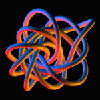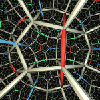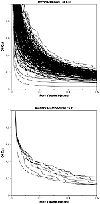
Summary Article
Mathematics -- The Science of Patterns and Algorithms
Introduction
The mathematical sciences identify and study structures; they formulate powerful concepts that can unify and clarify phenomena in the natural and technological worlds, in the other sciences as well as within mathematics1 itself; they organize and design efficient ways to compute; they form the very language of science. The start of the twenty-first century is a particularly exciting time. The mathematical sciences are faced with several new challenges due to the ever increasing demand for new mathematical conceptualization from biology and the other experimental sciences, the pressing new challenges posed by large scale computing and massive data sets, the many recent successes in fundamental as well as interdisciplinary mathematics, and the promise of even more as we confront the challenges ahead. Mathematical scientists are poised to make significant strides, to produce new structures, and to contribute to a galaxy of new problems, many of immediate importance to society.
|
The Hubble telescope provided new vistas for astronomers, with mankind sharing their excitement. Similarly, the mathematical sciences probe a beautiful, hidden universe to be explored by all. Every subfield can list several examples of wonderfully beautiful constructions that delight professional mathematicians and the public at large alike; think, for example, of Fermat's last theorem, knots, non-Euclidean geometry, and chaos and fractals. And the adventure of mathematics continues to attract new generations of mathematical scientists. The concepts and structures developed by fundamental mathematics often provide just the right framework for the formulation and study of applications in seemingly unrelated areas. Examples abound for this link from fundamental mathematics to applied and often interdisciplinary areas. Let us just name the importance of Hilbert spaces and Lie groups as the framework for quantum mechanics, the foundational work in logic and combinatorics as the basis for models of computation and the celebrated P versus NP problem, the use of fractals for many models of natural structures, the role played by knot theory in DNA enzymology, the geometrical framework essential for relativity theory, and the once surprising but now ubiquitous role of number theory in public key cryptography. Conversely, studies of particular applications and attempts to understand the world around us lead to abstract formulations and the definitions of new concepts, which enrich the science of fundamental mathematics, and indeed can sometimes create whole new fields. This mechanism gave us, for example, probability theory, developed from observations of the variability of everyday experiences; Fourier analysis, born from the use of trigonometric series to study the propagation of heat; the calculus of variations, rooted in mechanics and optimization; and differential equations, first proposed by Newton to describe mechanics and now used in virtually all the sciences; all giving rise to rich mathematics that provides powerful tools for the description of an extraordinary range of phenomena. More recently, the pursuit of efficient telecommunications drove the development of information theory, and the experimental observation of some types of wave propagation together with numerical experimentation led to solitons and nonlinear integrable systems. This interaction is most often two-way. Solitons, after their emergence from computational experiment, were soon adopted and pursued as an interesting but purely mathematical concept, with no thought of applications; they are now proposed for efficient signal transmission through optical fiber cables. Other examples include harmonic analysis and wavelet applications, each providing feedback to the other; and string theory, a customer for topology as well as a powerful engine driving new developments in algebraic topology. In all these connections between applications and fundamental mathematics, special excitement is generated by surprising linkages. This excitement is also present when unexpected connections come up between subfields within fundamental mathematics, such as the link between knots and algebra, or the links between logic and geometry, algebra and number theory. These are literally breakthroughs, breaching the walls between disciplines. Such sparks can generate whole new subfields, and they renew our constant wonder as we cross new terrain in the mathematical world. The science of mathematics, providing conceptual frameworks and a common language, is a powerful tool of insight, as well as a unifying force between all the sciences. Mathematical abstraction and language will be essential to identify the structures needed to organize the large volumes of data in emerging fields, to derive new implications and new predictions to be tested. We need sophisticated mathematical models and algorithms to make the link from measurable quantities to the structures we want to study. Mathematics played a crucial role in generating and assembling the fragments of the human genome. Completion of the sequencing of the genome has revolutionized biology, and will revolutionize many other areas of science. Translating the genome into knowledge about the function of genes requires extensive mathematical modeling. The mathematical sciences will play a significant role in understanding the complexities of life processes, and improving human health. On the other hand, new understanding of life processes may lead to new algorithms and new modes of computing. The mathematical sciences also serve as a vehicle for scientific cross-fertilization, when ideas from one area, abstracted and formalized by mathematicians, turn out to be essential in other areas. Dynamical system ideas, distilled from mechanics, find rich applications in ecology; approaches to the partial differential equations of fluid dynamics provide useful tools in image analysis; the wavelets/harmonic analysis synthesis was the bridge over which sub-band filtering, developed by electrical engineers, jumped to applications in medical data processing, and computational physics and chemistry [DA]; coding theory, developed to transmit and store information reliably in the error-prone world of communications and computers, later found applications in many other fields, including biology; statistical ideas, developed in connection with problems in the social sciences and agriculture, now permeate disparate fields, from genomics to finance. |
Click image for more information. |
|
![]()








